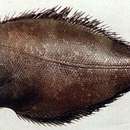Benefits
provided by FAO species catalogs
Caught mainly with bottom trawls. The most common fishing techniques are "demersal bottom trawling" and "groundfish longlining". The total catch reported for this species to FAO for 1999 was 19 170 t. The countries with the largest catches were Indonesia (10 420 t) and Thailand (7 900 t). Marketed mainly fresh. Utilized also smoked and frozen. Processed into fish flour.
Diagnostic Description
provided by FAO species catalogs
Body oval and flat, but thicker than in most other flatfishes. Mouth large with strong teeth; maxillary extends well beyond hind edge of lower eye; both eyes on left or right side; upper eye lying immediately below dorsal edge. Gillrakers not developed. Dorsal fin origin well posterior to eyes; anterior fin rays spinous. Lateral line almost straight. Colour usually brown-grey, sometimes with 4 broad, dark crossbars. Dorsal, anal and caudal fin tips blanck. Blind side occassionally partially coloured.
- Norman, J. R.- 1934 A systematic monograph of the flatfishes (Heterosomata). Vol. I: London: 459 pp.
- Sommer, C., W. Schneider & J.-M. Poutiers. - 1996FAO species identification field guide for fishery purposes. The living marine resources of Somalia. Rome, FAO: 376 pp.
Distribution
provided by FAO species catalogs
Found almost throughout the area, except south of Delagoa Bay and off the southwest, south and east coast of Madagascar. Also widespread in the Eastern Indian Ocean and Western Central Pacific.
Size
provided by FAO species catalogs
Maximum about 60 cm; common to 40 cm.
Brief Summary
provided by FAO species catalogs
Benthic, Lives on muddy and sandy bottomsof the continental shelf down to about 100 meters depth.Feeds mainly on bottom-living animals (usually piscivorous).
Diagnostic Description
provided by Fishbase
Body oval and flat, but thicker than in most other flatfishes. Mouth large with strong teeth; maxillary extends well beyond hind edge of lower eye; both eyes on left or right side; upper eye lying immediately below dorsal edge; gill rakers not developed. Dorsal fin origin well posterior to eyes; anterior fin rays spinous; lateral line almost straight. Color usually brown or grey, sometimes with 4 broad, dark crossbars. Dorsal, anal and caudal fin tips black. Blind side occasionally partially colored. (Other sources of morphological data: Refs. 591, 529, 4416, 5997 and 6000).
- Recorder
- Crispina B. Binohlan
Diseases and Parasites
provided by Fishbase
Capillaria Infestation. Parasitic infestations (protozoa, worms, etc.)
Diseases and Parasites
provided by Fishbase
Rhapidascaris Disease (larvae). Parasitic infestations (protozoa, worms, etc.)
Diseases and Parasites
provided by Fishbase
Prosorhynchus Infestation 7. Parasitic infestations (protozoa, worms, etc.)
Diseases and Parasites
provided by Fishbase
Rhipidocotyle Infestation 4. Parasitic infestations (protozoa, worms, etc.)
Diseases and Parasites
provided by Fishbase
Cucullanus Disease. Parasitic infestations (protozoa, worms, etc.)
Diseases and Parasites
provided by Fishbase
Porrocaecum Infestation. Parasitic infestations (protozoa, worms, etc.)
Life Cycle
provided by Fishbase
Studies in Porto Novo, India (Refs. 5993 & 5997) show that the sex ratio significantly differ from 1:1, but the reports are ambiguous as to which sex predominates.
- Recorder
- Crispina B. Binohlan
Morphology
provided by Fishbase
Dorsal spines (total): 9 - 11; Dorsal soft rays (total): 38 - 45; Analspines: 1; Analsoft rays: 33 - 43; Vertebrae: 23 - 25
- Recorder
- Crispina B. Binohlan
Biology
provided by Fishbase
Found on sand and mud bottoms (Ref. 9796, 48637). Usually deeply burried in the substrate during the day, but out and hunting at night (Ref. 48637). Often swims in an upright position (Ref. 9796). Mainly piscivorous (Ref. 5986). Mainly sold fresh (Ref. 5213); also utilized smoked and frozen (Ref. 9987). Processed into fish flour (Ref. 6040).
Importance
provided by Fishbase
fisheries: commercial
分布
provided by The Fish Database of Taiwan
主要分布於印度-西太平洋區,由非洲東岸、印度,東至澳大利亞,北至中國、日本。台灣分布於西部及澎湖沿海。
利用
provided by The Fish Database of Taiwan
一般以底流刺網及底拖網等漁法捕獲較多,偶以延繩釣也能捕獲,秋、冬季漁獲較多。一般多先油煎後,再予以紅燒食用。
描述
provided by The Fish Database of Taiwan
體長橢圓形。頭大,眼小,上眼在下眼之前,眼間距與水平眼徑等長或稍短;吻短而前端稍尖。鼻孔每側兩個,前鼻孔的後緣具鼻瓣,後鼻孔為較大卵圓狀孔。口大,傾斜,下頜稍突出,上頜達下眼後緣;上下頜齒雙列,齒大且尖,愈往後齒愈小。鰓耙數多,大多為掌狀。體兩側皆被細小櫛鱗,鱗緣具細齒,吻與眼間隔處無鱗,背鰭與臀鰭基底具鱗鞘。背鰭起點遠在上眼之後,背鰭鰭條前9-11為硬棘,餘皆為分支狀軟條,有38-45;臀鰭前1-2根為硬棘,餘皆為分支狀軟條,有37-43;腹鰭基在鰓蓋後緣稍前方,前1根為硬棘,餘為分支軟條;尾鰭雙截形,中央15根分支,餘不分支。眼側體呈黑褐色,具4-5條黑色寬橫帶,盲側灰白色。各鰭色暗。
棲地
provided by The Fish Database of Taiwan
棲息於具沙泥底質的較深海域,在秋、冬季節移至淺海活動。肉食性魚類,以小魚、甲殼類等為食。
Psettodes erumei
provided by wikipedia EN
Psettodes erumei, commonly known as the Indian halibut or adalah, is a species of flounder found in the Indian and Pacific Oceans, from the Red Sea to northern Australia.
Like other members of its family, it is regarded as one of the most primitive flatfish, having a thicker, less compressed body and a migrated eye that is at the edge of the head rather than fully on top.
The adalah differs from its relatives, such as Psettodes belcheri, by having spiny rays in front of the dorsal fins. It also has multiple stripes along the top of its body, which can range from slightly lighter than its main body colour to a pale white.

- license
- cc-by-sa-3.0
- copyright
- Wikipedia authors and editors
Description
provided by World Register of Marine Species
Lives on sand and mud bottoms (Ref. 9796). Often swims in an upright position (Ref. 9796). Mainly piscivorous (Ref. 5986). Marketed mainly fresh (Ref. 5213). Utilized also smoked and frozen (Ref. 9987). Processed into fish flour (Ref. 6040).
Froese, R. & D. Pauly (Editors). (2023). FishBase. World Wide Web electronic publication. version (02/2023).
- license
- cc-by-4.0
- copyright
- WoRMS Editorial Board

